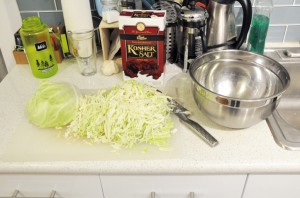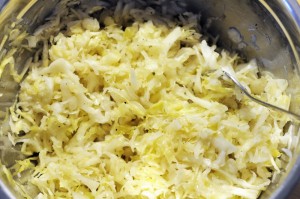
Sauerkraut is a great accompaniment to many different dishes. I like it best as a traditional side served with pork sausage, German potato salad, and some grainy mustard. Serve it with a stein of Munich Helles and you’ll be good-to-go.
Making sauerkraut seems like something that should be difficult. In reality, it is just about as easy as it gets in terms of food fermentation. I was inspired to begin fermenting vegetables after reading Sandor Katz’s book The Art of Fermentation. Sauerkraut is an excellent introduction and foray into the rabbit hole that is food fermentation.
Sauerkraut is shredded cabbage and salt that is mixed and allowed to ferment using the natural microflora present on the cabbage. There are a million variations which typically include the addition of different spices and perhaps other vegetables. You can go nuts trying different styles of kraut, but a simple version with just cabbage and salt is pretty delicious in its own right. The key, like most fermentation, is setting an environment that is conducive to producing a good, lactic fermentation, and not spoilage.
The first step is to take a head of washed cabbage and shred it finely. It is then mixed in a bowl with an ample amount of salt. I prefer coarse Kosher salt, but the type doesn’t really matter. Typically the amount of salt should equal approximately 1.5 – 2% of the cabbage’s weight. This is a general rule of thumb; experiment to see what best suits your taste. I generally don’t weigh the salt and instead sprinkle salt in between alternating layers of cabbage.
Once the salt and cabbage is mixed I manually compress and crunch the cabbage to allow the salt to draw water out of the cabbage. It is very important to draw out enough moisture so that it completely submerges the cabbage.
Once the cabbage begins giving up its moisture, it is time to pack it into a jar or bowl. I’ve found the easiest thing to do is pack it into a stainless steel mixing bowl. I then lay plastic wrap right on top of the cabbage and push out any air pockets. Your goal is to encourage lactic acid bacteria to ferment the cabbage by denying other microbes access to oxygen. The moisture in the cabbage mixture and plastic wrap seal should keep out most oxygen. On top of the plastic wrap I set a plate with a couple cans on top in order to further compress the cabbage and keep it submerged. Lastly, I cover the entire top with a piece of cheese cloth to keep out any fruit flies.
After amount a week, I like to taste the kraut. It should have picked up a nice tartness and be relatively clean tasting. If there is dark or oddly colored mold or putrid off-smells, it may have gone-off and should be tossed. That being said, I’ve never had a batch of kraut go off. Common sense should dictate your decisions. If it smells off, then you probably don’t want to eat it.
With a week of fermentation, the kraut will still be pretty crunchy and only mildly sour. The more time you give it at room temp, the tarter it will become. Once it is at a level you like, it is best to refrigerate it to retard any further fermentation. Once in the fridge, it should stay good for at least a couple months.


